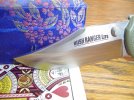I am brand new on the forum, and I need some help. I purchased a set of custom knives made from high carbon Damascus. I received them and was pleased, however they were not very sharp. I sharpened to a shaving quality with my wicked edge, but they still didn’t cut the way I wanted. To me they appear to thick and not tapered enough towards the cutting edge. If I were to attempt to reprofile them could it be done with an orbital sander or would I have to get a small belt sander. Once done I know they would have to be re-etched. I appreciate any Help
Are you in the USA? Did you buy these from a USA knifemaker? If so, then any knifemaker who values their name should be willing to fix this issue for you. It might be they ask for a little bit extra money to pay for it if they believe the knives are good as delivered, but most people value their reputation enough to do it.
If you do it yourself, there are a number of issues. The knives are already heat treated and tempered, so while grinding them, you must make sure you do not raise the temperature of the steel above the original tempering temperature as it will soften the steel. This is difficult for thin knives especially at the tip because there is less mass to act as a thermal sink. When grinding already heat treated and tempered blades, I always dunk the blade in a bucket of water after every pass on the belt grinder. You can use a Harbor Freight 1x30 belt sander as your grinder, but beware that the platen is very small and thin, and it will heat up as you grind on the blade too. Then you'll probably need to hand sand the blade to get the grinding scratches homogenous. Some people, especially Japanese kitchen knife enthusiasts prefer to thin down blades on diamond plates or waterstones thus avoiding the issue of overheating the steel, but you'll still want to reach an even scratch pattern before etching.
Another issue you have to worry about is re-etching the damascus. You'll have to mask the handle off in a way that the etchant won't soak into the handle material or soak into it. Make sure the entire blade is sanded evenly without deep low grit scratches. Some people like to stop at 400 grit for carbon damascus, but I like to go even higher and do multiple etches in ferric chloride until I'm happy with how it looks. Beware that leaving low grit scratches will show up in the etch because the etchant will attack and etch the scratches deeper.
All in all, what you want to do is a pain, and that's why I would recommend trying to get the maker to fix the issue. If you bought these knives from a foreign seller located in India, Pakistan, or China, the chances are the damascus steel is of low quality and then I say just try it because you're probably not out too much money if you mess them up.
A damascus knife that I made:


